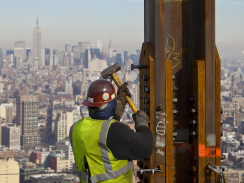Construction crews set in place a steel horizontal beam at a height of about 1,270 feet, topping by about 20 feet the rooftop of the observation deck of the Empire State Building, which stands about 3 miles (4.8 km) to the north in Midtown Manhattan.
Including the antenna tower, however, the iconic Empire State Building is still higher.
The Empire State Building, built in 1931, was the city's tallest at a height of 1,545 feet to the tip of its broadcast antenna until 1972 when it was overtaken by the original World Trade Center towers. It then regained the title after the September 11, 2001, attacks, which destroyed the complex.
Construction started six years ago on the new World Trade Center and now the skyscraper, formerly called the Freedom Tower, surpasses the top floor of the Empire State Building, Port Authority officials told reporters.
One World Trade Center will stand at 1,776 feet to the tip of its antenna when it is completed, possibly by late 2013. Then it will top the Empire State entirely.
Click here to view a time-lapse video of the World Trade Center construction. BD+C
Related Stories
Architects | May 17, 2015
NCARB wants the title ‘architect’ confined to those who are licensed
The Council is urging state licensing boards to come up with a substitute for the pre-licensure title ‘Intern.’
Museums | May 13, 2015
The museum of tomorrow: 8 things to know about cultural institutions in today’s society
Entertainment-based experiences, personal journeys, and community engagement are among the key themes that cultural institutions must embrace to stay relevant, write Gensler's Diana Lee and Richard Jacob.
Industrial Facilities | May 11, 2015
SOM-designed Manufacturing and Design Innovation Institute opens in Chicago
The new space will be a place for academia, industries, and civic bodies to collaborate.
Sponsored | Roofing | May 11, 2015
How architects can tap into the expertise of their metal roof manufacturer, part 2
Here are three things metal roof manufacturers can do to help the architect
BIM and Information Technology | May 10, 2015
How beacons will change architecture
Indoor positioning is right around the corner. Here is why it matters.
Architects | May 10, 2015
Harness the connection between managing risk and increasing profitability, Part 2
In Part 1, we covered taking control of the submittals schedule and managing RFIs. Let’s move on to properly allocating substitutions and limiting change orders.
Architects | May 10, 2015
Harness the connection between managing risk and increasing profitability, Part 1
AE firms need to protect themselves against vague contractual and procedural situations during all phases of the project in order to minimize their liability and exposure to risk, writes AEC industry consultant Steve Whitehorn.
Building Team | May 8, 2015
Construction industry adds 45,000 jobs in April
The construction industry saw an increase in jobs during the month of April after losing approximately 9,000 positions in March.
Building Team | May 8, 2015
Surety bond forms specifically for design-build projects now available
The documents are the first of their kind to be coauthored by designers and builders.
High-rise Construction | May 6, 2015
Parks in the sky? Subterranean bike paths? Meet the livable city, designed in 3D
Today’s great cities must be resilient—and open—to many things, including the influx of humanity, writes Gensler co-CEO Andy Cohen.

















